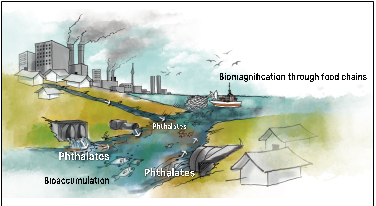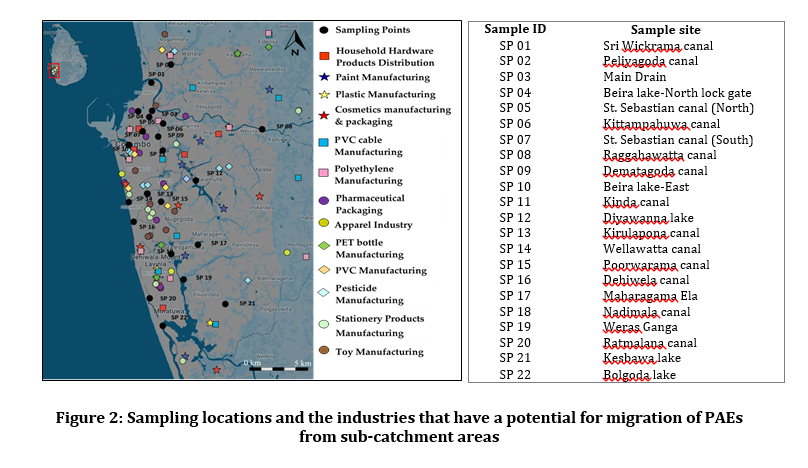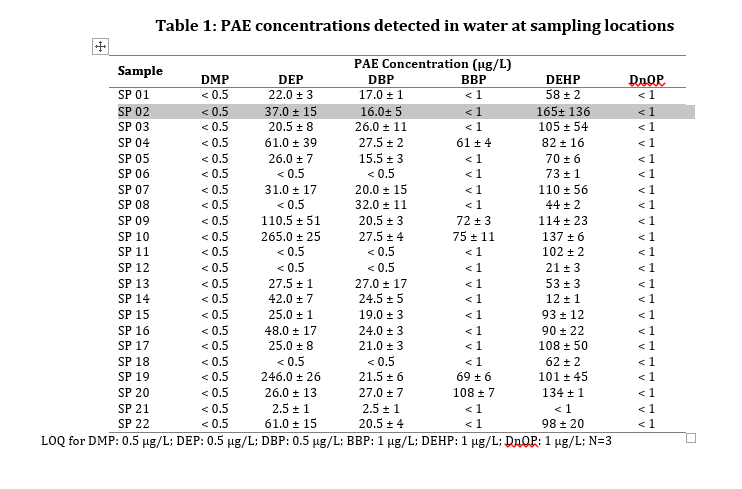Intriguing levels of phthalic acid esters in coastal urban watercourses of Colombo and its suburbs:
a bizarre situation caused by urban sprawl

Phthalic acid esters: another emerging contaminant of concern
Phthalic Acid Esters (PAEs) are reported to be a group of emerging complex organic contaminants, which is ubiquitous in the aquatic environment and seems to be often released to the environment as a consequence of urban sprawl. PAEs are generally, added to plastic and polyvinyl chloride manufacturing industries as a plasticizer to enhance the beneficiary attributes of final products such as softness, flexibility, durability and longevity, and workability. PAEs are also found in pharmaceuticals, cosmetics, personal-care products, insect repellants, household-hardware, including wire coverings, cables, tubes, hoses, lubricants, stationery products (such as inks, paints), toys, and pesticides. The urban sprawl results in PAEs to be ubiquitous at astounding levels in watercourses, especially in developing countries. The urbanization and industrialization are the possible major sources of PAEs in urban watercourses (Fig. 1). Among all PAEs, six compounds, namely dimethyl phthalate (DMP), diethyl phthalate (DEP), di(n-butyl) phthalate (DBP), benzyl butyl phthalate (BBP), bis(2-ethylhexyl) phthalate (DEHP), and di(n-octyl) phthalate (DnOP) have been included in the priority pollutant list published in Appendix A to Part 423 of Title 40 of the Code of Federal Regulations (40 CFR, Part 423) US Government. Canadian water quality guidelines specify the levels of DEHP and DBP to be 16 and 19 ug/L, respectively, for the protection of aquatic life. PAEs are not bound to a polymer by covalent bonding resulting in easy detachment and may subsequently transport through leaching to the aquatic environment. DEHP and DnOP are weak in biodegradability and hence, subject to bioaccumulation with a likelihood of biomagnification in the aquatic environment.

Figure 1: Schematic diagram of ingress of PAEs into the urban watercourses
What role do the coastal urban watercourses play?
Coastal watercourses are the conduits of diverting essential nutrients, contaminants, and sediment loads to the oceans. However, their transport phenomena are solely dependent on hydrodynamics, hydrogeochemistry, and tidal dynamics of the coastal stretch of concern. PAEs as a group of emerging contaminants are found along such open shallow watercourses making them available in a multitude of congeners with subsequent adverse impacts on aquatic biota and humans.

This article, therefore, reports a study done by the authors on the occurrence of PAEs in coastal urban watercourses in Colombo and its suburbs (particularly the lower stretches of watercourses). Figure 2 shows the 22 locations at which water samples were collected for PAE analysis and the distribution of industries that have a potential for PAE release to the watercourses selected for the study.
Some of the principal influencing factors for the retention of PAEs in the water column include pH, temperature, and salinity. PAEs are hydrolyzed below pH 5 and above pH 7 and have high hydrophobicity with increasing salinity
resulting in a negative impact on water solubility.
PAEs show positive relationship with temperature of the water column.
Further, the sorption affinity of colloid-laden PAEs declines with
increasing concentrations of Na+, K+, Cl-, and SO42- of colloids.
Other factors of concern constitute solubility in water, Octanol/water partitioning, air/water partitioning, water/solid partitioning, photodegradation, and biodegradation. Low or almost stagnant flows in the lower reach of these watercourses provide prolonged access for aquatic biota to PAEs.
Intriguing Levels of PAEs ubiquitous in watercourses
Gas Chromatograph coupled with a Mass Selective Detector (GC/MS) was used for the qualitative analysis of PAEs. DEP, DBP, BBP, and DEHP were found in most of the watercourses, while DMP and DnOP were below the respective levels of quantification (0.5 ug/L for DMP and 1.0 ug/L for DnOP) for all the watercourses (Table 1). The average concentrations detected for DEP, DBP, BBP, and DEHP were in the range of 2.5-265.0, 1.0-32.0, 61-108, and 12-165 ug/L, respectively and these average values were compared with the same detected in the watercourses of different countries (Table 2). DEHP and DBP in most of the watercourses of our study exceeded those of Canadian permissible levels (16 and 19 ug/L) for the protection of aquatic life.

On the other hand, DMP, DBP, and DnOP concentrations were of the same order of magnitude as reported in other countries, while DEP, BBP and DEHP concentrations detected were more than one order of magnitude higher than those observed in many of the other countries (Table 2). The possible factors for a vast variation of PAE concentrations of the watercourses (Table 2) include a varying degree of migration potential of PAEs from industries and households, inherent properties of PAEs (volatility, solubility, biodegradability, photodegradability), quality of the receiving water (pH, salinity, temperature), and extent to which such PAEs are regulated.

Plausible reasons for the occurrence of copious levels
The major reasons for the copious levels of PAEs present in lower reaches of the urban watercourses may be the mushrooming of industries releasing PAEs within the sub-catchments (Fig. 2). It is a bizarre situation to note that almost all industries utilizing PAEs in their production have been located in Colombo and its suburbs. Another plausible reason would be the ever-increasing high population densities in Colombo and its suburbs, which may intentionally or inadvertently release PAE-rich products in the form of solid waste. Other factors affecting the ubiquitous presence of PAEs in the urban watercourses of concern are the inherent properties of each PAE (such as volatility, solubility, biodegradability, photodegradability) that could trigger its persistence, presence of industrial and household products dissolved in wastewater with a great potential for migration of PAEs in the water column, and quality of the receiving water (such as pH, temperature and salinity) that could assist with the prolonged retention in the watercourses.
Resilience of an imminent ecological disaster or manmade calamity
It is apparent that the contamination of PAEs in most of the watercourses is detrimental for the protection of aquatic life, as concentrations of DEHP and DBP were higher than those of Canadian permissible concentrations (16 and 19 ug/L). Because of the low- or non-flowing hydraulic regime prevalent in coastal urban watercourses, PAE-rich water may be pervasive until monsoon-driven run-off carries such flows to the ocean. Until such time, the water column is a rich foraging ground for many biological forms, and consequently, bioaccumulation of PAEs begins. Carnivorous fish are often found to get PAEs transferred from the prey that is rich with PAEs in many orders of magnitudes, and the PAE levels of such carnivorous fish are steadily on the rise. This phenomenon is known to be the processes of bioconcentration and biomagnification with extended half-lives of PAEs in fish (one to several weeks). The Majority of PAEs consequently, transfers to humans and can act as a potent teratogen, neurotoxin, and endocrine disruptor.
Sri Lanka has been a fabulous country in producing shellfish [crustacea (such as shrimps, crabs, lobsters) and mollusks (such as clams, mussels, oysters, scallops)], which is a delicacy for many. However, with the unprecedented levels of PAEs found in the coastal aquatic environments, the shellfish industry may topple in no time with a likelihood of Sri Lankan seafood being banned for human consumption. Such a bleak era seems to be close at hand unless we would be proactive collectively to say 'no' to sources containing and spewing astounding levels of PAEs. In this context, regulations on PAEs that are to be added to different diverse products need to be promulgated and enforced. Further, it is imperative that a rigorous scheme of PAE measurements is paramount, as the behavior of PAEs in the aquatic environment seems to be not fully understood. It is our fervent obligation to leave the coastal environments free of PAEs for better ecological sustenance for which strict principles of resilience need to be implemented so that a bizarre situation detrimental to ecological health could be avoided.





